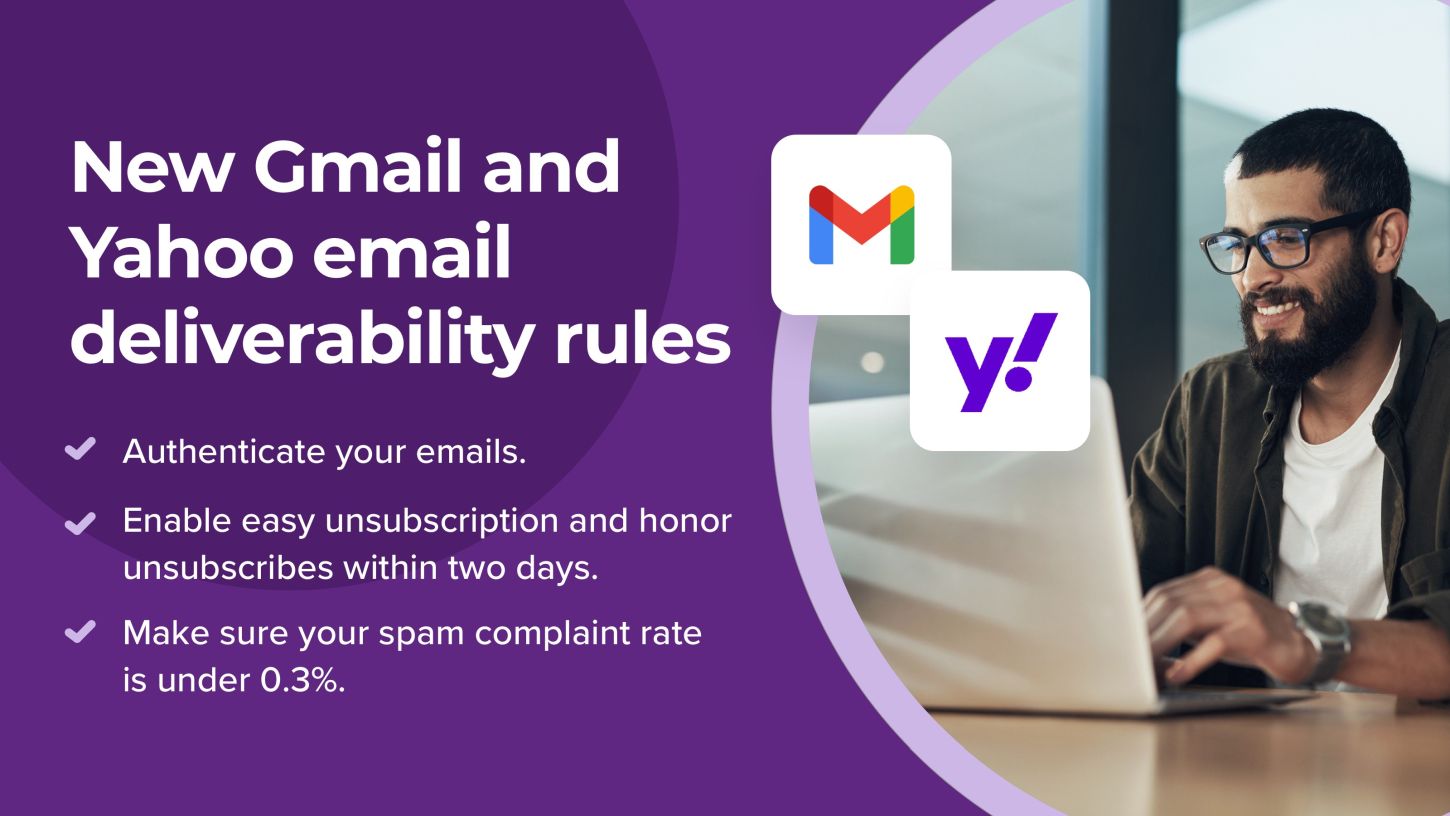
How to Ensure Email Compliance: A Guide for Your Business
Email is a profitable marketing channel – not to mention it’s vital for your business operations. But how do you ensure email compliance across your organization? In this article, OPTIZMO’s Chief Operations Officer Tom Wozniak guides you through the steps.
Forty-six years after the first email marketing campaign was sent, the channel just keeps connecting with consumers and driving conversions. It has certainly evolved since those early days of emails being simply text on an old, bulky, black and white (or maybe black and green) desktop computer screen.
Those early marketers likely couldn’t have envisioned that email would become a cornerstone of individual identity in the emerging digital world, or that it would remain arguably the most cost-effective marketing channel for nearly 50 years running.
While there are any number of reasons why email continues to be such a powerful marketing channel, one reason may seem counterintuitive – regulation. When senders ensure email compliance, it makes email a safer and more effective communication channel.
How email compliance laws have evolved
For the first few decades of email marketing’s existence, there were limited laws and regulations governing how marketers could leverage the email channel to connect with recipients. However, as with most technologies that come to gain mass adoption, laws were enacted to create guidelines for the continued use of email as a marketing vehicle.
In the United States, the CAN-SPAM Act was passed in 2003, providing the industry with clear rules for engaging in email marketing and allowing the channel to flourish over the next two decades.
What is the CAN-SPAM Act?
The CAN-SPAM Act came into being to create a nationwide set of rules to regulate the use of email for marketing purposes. While the law is very detailed, there are eight areas that the FTC has called out for marketers to follow in order to remain in compliance.
8 key aspects of CAN-SPAM compliance
- Use accurate header information. This means your From, To, Reply-To, and routing information need to be accurate and identify the person/business initiating the email message.
- Do not use deceptive subject lines. The subject line should reflect the content of the message.
- Make it clear the message is an advertisement. Marketers are given leeway to accomplish this in various ways, as long as the disclosure is clear and conspicuous.
- Provide a valid physical postal address. Recipients must be informed of where the sender is located.
- Provide recipients with a clear and conspicuous way to opt out of future marketing email messages. This is arguably the most important guideline defined in CAN-SPAM. Marketers must provide email recipients with a straightforward way to opt out of receiving future email marketing campaigns. Today, this is generally accomplished with an unsubscribe link in every marketing email.
- Members and subscribers must be able to opt out of marketing emails. This is a more recent clarification that even subscribers or customers can opt-out specifically from email marketing messages from a company, while still receiving non-marketing messages.
- Honor opt-out requests within 10 business days. Today, most marketers honor requests much more quickly, but the law allows for 10 days to process and honor opt-out requests.
- Monitor what third parties are doing on your behalf. This is an important rule for advertisers who leverage affiliates, marketing agencies, or other third parties in their email marketing campaigns. If those third parties violate the law, the advertiser can also be held legally accountable.
CASL, GDPR, and other international email compliance laws
While CAN-SPAM provides the rules of the road for email marketing in the U.S., there are countless laws that regulate how email marketing can be sent in other countries around the world.
Some of the most well-known are:
- CASL (Canada Anti-Spam Legislation)
- GDPR (the General Data Protection Regulation in the European Union).
However, most countries have their own email marketing laws. One of the most impactful elements of these laws is whether or not recipients are required to opt-in prior to receiving email marketing messages.
In the U.S., a prior opt-int is not required
As of 2024, most countries outside the U.S. require an affirmative opt-in prior to marketers contacting consumers via email. In the U.S., a prior opt-int is not required. However, virtually all countries include a requirement to provide a way to opt out in every marketing email.
Platform-specific compliance
While not legal requirements, various email inbox providers have begun creating rules impacting larger-scale email marketers (those sending 5,000+ emails into these platforms each day). In particular, Gmail and Yahoo! have instituted a set of rules for larger mailers to have their campaigns delivered to the inbox. These rules typically go above and beyond the legal requirements imposed by CAN-SPAM.
Gmail and Yahoo sender requirements
This year, Google and Yahoo – two of the world’s largest email providers – enforced a new set of guidelines for mass senders. These guidelines prioritize user experience, thus helping to make email safer and more enjoyable for it’s four billion users around the world.

Leverage the list-unsubscribe header
The list-unsubscribe header is a feature built into many inbox providers, allowing email recipients to opt-out of receiving future emails from the sender via a link in the email header. It shows up as a clickable Unsubscribe link at the very top of the email message, next to the sender email address, when the email is opened in the user’s inbox.
CAN-SPAM does not define the specific opt-out mechanism, although the standard practice is to include an unsubscribe link in the email itself, typically in the footer. Most email-sending platforms automatically include this link in the footer of every marketing email sent from their systems.
Honor opt-outs within two days
CAN-SPAM allows for a 10-day processing period before honoring opt-outs, although many marketers honor them almost immediately. The new Gmail and Yahoo! sender requirements shorten this required period to two days.
Keep spam rates below 0.3%
The new sender requirements also have email marketers focus on sending relevant messages to recipients. So, this limit on spam complaints is put in place to limit the amount of truly unwanted emails being sent to consumers.
Leverage various email authentication processes
Mailers are required to use various email authentication processes to establish trust that the sender is legitimate and their sending domain secure.
Best practices to ensure email compliance
While not required by law or by key inbox providers, there are also a range of industry best practices that aim to improve email marketing performance, from deliverability to engagement, to conversion.
Here are three common best practices that can have a significant impact on long-term email campaign success.
Validate, verify, and cleanse email lists
The first step to having a successful email campaign is making sure your messages actually reach recipient inboxes. While there are many ways to improve overall deliverability, ensuring your mailing list is as clean as possible, weeding out invalid addresses from your list prior to sending. Using a service like ZeroBounce can help dramatically improve your deliverability and overall email campaign performance.
Use audience segmentation
One of the best ways to ensure you send relevant information to recipients is to use audience segmentation to identify key groups within your larger list. That information can be used to tailor email content to each segment. More relevant content leads to higher engagement, lower spam and unsubscribe rates, and generally better performance.
Have a clear call-to-action
If a marketing email has a goal of getting recipients to click on a link to purchase a product, fill out a lead form, or visit a website for more information, make sure that action is called out clearly in the email content. Clear and simple CTAs drive more responses.
Author: Tom Wozniak is the Chief Operations Officer for OPTIZMO, delivering the industry’s most robust platform for email compliance and suppression list management to clients throughout the U.S. and around the world.
Table of Contents
- How email compliance laws have evolved
- What is the CAN-SPAM Act?
- 8 key aspects of CAN-SPAM compliance
- CASL, GDPR, and other international email compliance laws
- In the U.S., a prior opt-int is not required
- Platform-specific compliance
- Gmail and Yahoo sender requirements
- Leverage the list-unsubscribe header
- Honor opt-outs within two days
- Keep spam rates below 0.3%
- Leverage various email authentication processes
- Best practices to ensure email compliance
- Validate, verify, and cleanse email lists
- Use audience segmentation
- Have a clear call-to-action






